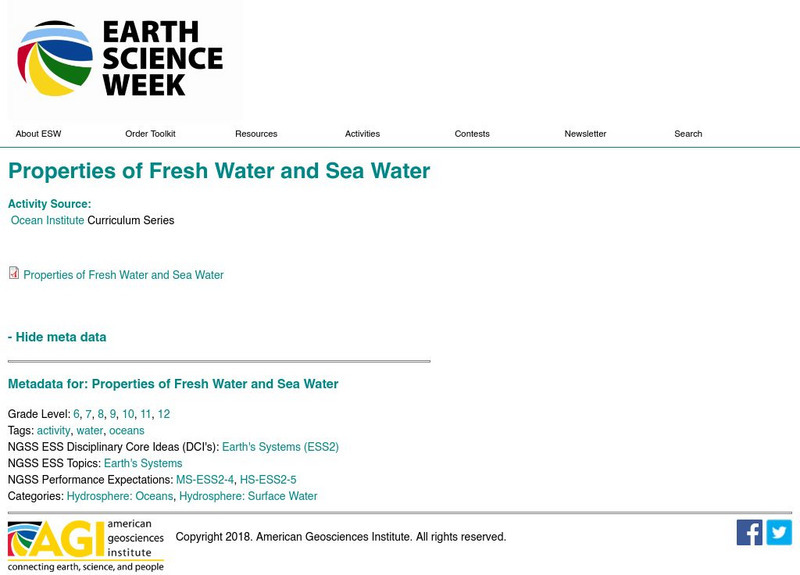American Geosciences Institute
American Geosciences Institute: Earth Science Week: It's About Time
To understand how a geologic time works, students make a personal timeline and compare it to a geologic timeline.
American Geosciences Institute
American Geosciences Institute: Earth Science Week: Land and People: Finding a Balance
Student groups will be asked to present and justify a solution to a real environmental dilemma concerning water usage.
American Geosciences Institute
American Geosciences Institute: Earth Science Week: Logs of Straw Dendrocronology
Using straws to recreate tree rings, students learn how dendrochronologists work. Construct a 50-year climatic history on a three-meter time line.
American Geosciences Institute
American Geosciences Institute: Earth Science Week: Magnets at the Core
Young scholars simulate magnetic pole reversal to study the movement of Earth's magnetic poles.
American Geosciences Institute
American Geosciences Institute: Earth Science Week: Make Your Own Powers of Ten
Watch Charles and Ray Eames's Powers of Ten video, and then create a similar project while exploring scale.
American Geosciences Institute
American Geosciences Institute: Earth Science Week: Mapping Quake Risk
Learners use GIS to observe worldwide patterns of earthquakes and volcanoes and analyze the relationships of those patterns to tectonic plate boundaries. Then they identify cities at risk.
American Geosciences Institute
American Geosciences Institute: Earth Science Week: Properties of Fresh Water and Sea Water
Students set up three demonstrations to observe the properties of water. They explore the boiling point of water, the freezing point of water, and the ability of water to store heat.
American Geosciences Institute
American Geosciences Institute: Earth Science Week: What Lies Beneath the Upper Crust?
Students use the Integrated Ocean Drilling Program as an example to help them find ways of checking science news stories for accuracy. They are given a science news story and instructed to investigate the accuracy of the claims made in...
American Geosciences Institute
American Geosciences Institute: Earth Science Week: Your Own El Nino
Find out how to create a miniature El Nino with simple, household materials.
American Geosciences Institute
American Geosciences Institute: Earth Science Week: Your Own Greenhouse
Climate scientists around the world study greenhouse gases and the ways they affect global climate. By making a small greenhouse, recreate the greenhouse effect and measure its effect on temperature.
American Geosciences Institute
American Geosciences Institute: Earth Science Week: Getting the Oil Out
Middle schoolers build an artificial lifting system prototype to test the ability to pump oil.
American Geosciences Institute
American Geosciences Institute: Earth Science Week: Gold Panning
Have students simulate the Gold Rush by panning for gold in the classroom.
American Geosciences Institute
American Geosciences Institute: Earth Science Week: Groundwater Movement
Students learn how water moves through rock materials such as sand, gravel, and clay.
American Geosciences Institute
American Geosciences Institute: Earth Science Week: Hands on Experiments to Test for Acid Mine Drainage
Fifteen short experiments which test acid mine damage to the streams, rivers, and creek ecosystems surrounding it.
American Geosciences Institute
American Geosciences Institute: Earth Science Week: How Much Soil Is There?
Study Earth's surface using an apple as a model of the Earth.
American Geosciences Institute
American Geosciences Institute: Earth Science Week: Identifying Your Watershed
Students identify the watershed they live in and study the pathway of surface runoff which ultimately becomes the source of water used at home,
American Geosciences Institute
American Geosciences Institute: Earth Science Week: Make a Thunderstorm
Students learn about convection and how air moves through a simulation.
American Geosciences Institute
American Geosciences Institute: Earth Science Week: Make Your Own Compass
Students create their own magnetic compass.
American Geosciences Institute
American Geosciences Institute: Earth Science Week: Mapping a Refuge
An observation-based investigation for students while visiting a national wildlife refuge.
American Geosciences Institute
American Geosciences Institute: Earth Science Week: Measure for Measure
In this activity, students will calculate scales of distance and length as used by ocean drilling scientists.
American Geosciences Institute
American Geosciences Institute: Earth Science Week: Mineral Electrical Conductivity
The purpose of this activity is to test the conductivity of various minerals with a simple electrical circuit and draw conclusions about which ones would be used in electronics.
American Geosciences Institute
American Geosciences Institute: Earth Science Week: Predict the Flow
Using a common modeling compound, students form a "volcano" and examine its topography to predict which way lava will flow down its slopes.
American Geosciences Institute
American Geosciences Institute: Earth Science Week: Splish Splash
Students conduct a large-group brainstorming session on the various places where liquid water can be found on Earth. Then they create a list of places, such as oceans, lakes, rivers, aquifers and trace the path the water travels.
American Geosciences Institute
American Geosciences Institute: Rock Chart [Pdf]
A rock chart the describes the texture, appearance, characteristics, type, and where each is formed.
























